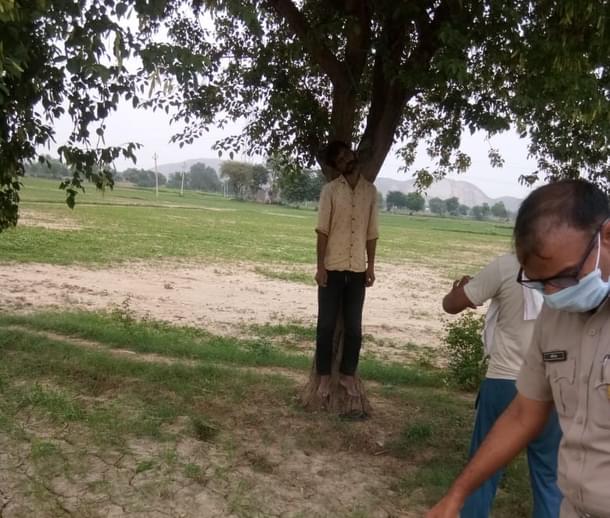Politics
Voices From Alwar: The Grassroots Reality Behind The Ugly ‘Lynchistan’ Propaganda
Swati Goel Sharma
Jul 07, 2020, 11:08 AM | Updated 11:07 AM IST
Save & read from anywhere!
Bookmark stories for easy access on any device or the Swarajya app.


What does a ‘Hindutva laboratory’ look like? What does a ‘Hindutva laboratory’ where Muslims live in perpetual fear of Hindus look like?
Does it look like a place where a minor Hindu girl jumps into a well to kill herself after months of gangrape by a neighbouring Muslim family? Where her father is found hanging from a tree on the day she is scheduled to give her statement in the court? Where the local police is found to have sided with the Muslim perpetrators and mistreated the Hindu victims?
Three years after Rajasthan’s Alwar district was labelled by a narrative-hunting national media and professional Muslim victimhood organisations as a Hindutva den where Muslims are lynched by Hindus with impunity, the ground reality belies the claims.
The disturbing incident cited above took place in Balot Nagar of Alwar’s Ramgarh tehsil three weeks ago.
A minor Hindu girl jumped into a well on 18 June, but was rescued by locals. She said she wanted to end her life as she had become a source of stress for her family. A neighbouring man, Mohammad Anis, had been molesting her for a year along with his brothers. The police did not file an FIR immediately as mandated and allegedly insulted the girl as “loose”.
They filed a case only when Hindu organisations agitated outside the thana. On the day when the girl was scheduled to record her statement in the district court, her father, Shravan, was found hanging from a tree 500 metres from the house. The family accused the Muslim men of murder.
Balot Nagar is an almost 80 per cent-Muslim locality. The Hindu family is said to be the only Brahmin caste family living here.

What busts the lies about Alwar even more is that the incident took place within two kilometres of the village, Lalawandi, where a Muslim man was beaten by a group of Hindu men in 2018 which allegedly led to his death a few hours later.
Rakbar Khan, a chargesheeted cattle thief, was caught by villagers when he was dragging two non-milch cows through a field in the dead of the night, and was handed to the police. He died while in police custody.
One is compelled to ask: if the death of Rakbar Khan indeed sent a wave of shock and fear in the local Muslim community as alleged, what gave the Balot Nagar’s Muslim family the heart to gangrape a minor neighbouring Hindu girl for months and thrash her brothers for objecting to it?
Most of the incidents that the media used for maligning Alwar were related to so-called cow vigilantism and took place in Ramgarh tehsil. Ramgarh lies on the border of Rajasthan and shares its boundary with Haryana’s Nuh district. That this ‘Mewat’ belt is notorious even in police and court records as a den for “organised” and “deadly” cattle-smuggling mafia was not revealed in most media reports.
Of the three Muslim men killed by vigilantes in most infamous cases reported from Ramgarh in 2017 and 2018, two had a prior history of cattle theft and slaughter. They were Umer Mohammad, a resident of adjoining Bharatpur district and Rakbar Khan, a resident of Nuh district. The third, Pehlu Khan, also a resident of Nuh district, was posthumously charged for cattle-theft too, but the Rajasthan High Court dismissed the FIR against him for want of “evidence”.
The dropping of the charge was hardly surprising, given that convictions are abysmally low in cattle-theft and slaughter cases.
Last year, the Nuh police was lambasted by the Haryana High Court when it came to light that out of 800 cases filed under the “stringent” state Anti-Cow Slaughter Act between November 2015 and March 2019, there had been zero convictions and 100 per cent acquittal. In the coming months, the Nuh police chief was forced to admit that much of it was because the local police was either not trained or deliberately let the accused go scot-free.
While the data for Rajasthan is now known, a 2015 report by Hindustan Times noted that one Munnibai had become the first person in the state ever to be convicted for killing a cow. “Historic conviction,” the report said.
With such abnormally high chances of acquittal, criminals in Nuh and adjoining towns in Alwar enjoy a free run. Journalists ignorant of ground reality typically describe such criminals as ‘dairy farmers’.
The media described Pehlu, Rakbar and Umer as dairy farmers too. A year after Umer’s death, his son Maqsood Khan was arrested for indulging in the same crime of cattle-smuggling as his father. This was despite the state government’s generous compensation to the family after Umer’s death.
That the fear-mongering by the media had little bearing on the ground became evident, in fact, less than two weeks after Rakbar’s death.
When the media was wondering on behalf of Muslims of Ramgarh if they could even legally own a cow, three Muslim women were caught red-handed with 221 fresh cow hides only 10 days after the Rakbar case.
The illegal slaughtering was taking place in a Hindu-populated village in Govindgarh, less than 30 kilometres from Lalawandi. Several men and women were booked under the Anti-Cow Slaughter Act, but were promptly let off on bail and, as is the norm in most such cases, continue to roam free.
The everyday, grassroots reality in Ramgarh today is more akin to its neighbour Nuh more than an imagined ‘Hindutva den’.
A retired district and sessions judge from Haryana who recently prepared a report on atrocities against Dalit Hindus in Nuh, concluded that “Aurangzeb-like brutal atrocities are being committed against Dalits” in Nuh.
Nuh is almost 80 per cent Muslim, while Ramgarh tehsil recorded 38 per cent Muslims in the 2011 Census. Locals say the demography in Ramgarh and adjoining Bharatpur is changing rapidly in favour of Muslims.
They say the criminal elements in the Muslim community enjoy political patronage under the current Muslim MLA of Ramgarh who belongs to the Congress government.
In the 2019 elections, Shafia Zubair won by around 12,000 votes defeating Bharatiya Janata Party’s (BJP’s) Sukhwant Singh. The former MLA of Ramgarh, BJP’s Gyan Dev Ahuja, was not given a ticket owing to his growing unpopularity among Hindu voters, who were miffed with his inaction in several cases including Govindgarh’s.
Here’s a look at a few reports from Ramgarh over the past year:
- June 2019: A mob of Muslim people assaulted transgenders with rods and looted them
- August 2019: A Dalit man committed suicide because he was unhappy with police probe in death of his son, allegedly by a Muslim mob
- September 2019: A Dalit woman was molested and looted on road by a group of Muslim men
- October 2019: Two Muslim men beat up a doctor over a spat
- December 2019: A minor Sikh girl was kidnapped by a Muslim man. She was rescued after nearly a month
Most of these cases got a passing mention in the local media and did not make it to the national press.
It is through invisibilisation of such victims even before 2017 that the national press ran its propaganda around Alwar.
If the Muslim community is indeed living in fear of Hindus and the district is indeed turning into a “Hindutva laboratory” as claimed, it should reflect on the ground.
Picture of a limp body of 46-year-old Shravan Kumar hanging from a tree, however, reveals a completely different reality.
Are Hindus guinea pigs in a “Hindutva laboratory“ crafted by the media?
Swati Goel Sharma is a senior editor at Swarajya. She tweets at @swati_gs.





